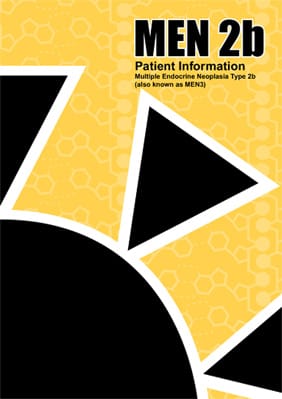What is MEN3 (formerly MEN2b)?
There are two main tumors common to MEN3. These occur in the butterfly-shaped thyroid gland in the neck, and less commonly in the adrenal glands that sit on top of each kidney. The tumor in the thyroid gland is always cancerous (medullary thyroid cancer or MTC) and is more aggressive in MEN3 than in those of MEN2. Each type of tumor may occur alone and independently of MEN.
Blood and urine tests for hormone levels as well as scans of the neck and abdominal area are all used to check for tumors. If a tumor is found surgery may be needed to remove either just the tumor itself or the whole of the affected gland. This is necessary as early as possible in childhood for the medullary thyroid cancer.
Thyroid Cancer
The butterfly-shaped thyroid gland is found at the base of the throat in the front of the neck. Almost 10 out of 10 (100%) of MEN3 patients will develop medullary thyroid cancer (MTC) sometimes within the first year of life. The thyroid cancer or the pre-cancerous hyperplasia, may be found using blood tests to measure levels of calcitonin. Treatment involves an operation to remove the thyroid gland and the nearby lymph nodes (total thyroidectomy and central lymph node dissection).
After surgery lifelong medicine called levothyroxine needs to be taken. If calcitonin is detected after the operation, further surgery and other therapies are used to control it. MTC is usually slow growing and may often be managed effectively in this way without symptoms for many years. Children identified as having MEN3 are offered a thyroidectomy within the first year of life. Parathyroid glands are sometimes unavoidably removed at the same time as the thyroid gland (see parathyroids).
Parathyroid Glands
These small glands lie just next to or are sometimes embedded within the butterfly-shaped thyroid gland in the neck and help to control calcium levels in the body. Owing to their location, these glands may be unavoidably removed or injured during thyroid surgery. If the parathyroid glands are removed or injured, patients will usually have to take a daily Vitamin D capsule to help the body absorb calcium from the diet.
Adrenal Glands
The body’s two adrenal glands are normally each about the size of a whole walnut and sit just on top of the kidneys. A tumor of the inner part of the adrenal gland is called a phaeochromocytoma (fee-o-cromo-sy-toma) and is almost always benign (not cancerous) in MEN. Phaeochromocytomas may grow for many years without causing severe symptoms but can be activated by events such as childbirth or surgery. Symptoms are varied and may include all or some of the following: sudden migraine-like headaches, palpitations, breathlessness, excessive sweating, high (or rarely low) blood pressure (constant or off- and-on), trembling, tiredness, depression, anxiety, and nausea with or without vomiting.
These tumors may be detected using blood and urine tests as well as several different types of scan. Treatment involves an operation to remove the gland and tumor. A period of medicine before surgery is necessary to control the unstable blood pressure. If both adrenal glands are removed, lifelong steroid replacement therapy is necessary.
Author: Jo Grey, AMEND CEO, with the help of the AMEND Medical Advisory Team
Further Reading
-
MEN2B Patient Information Book (UK)

Updated 3rd edition of this popular book on MEN2B (aka MEN3) by AMEND in the UK.
View Booklet
VIDEOS
The following films were produced by AMEND UK in early 2019 to raise awareness of MEN2B, to encourage earlier diagnosis, and to support other patients.
Hard of hearing? These films are available with subtitles via their YouTube channel.
Funded by AMEND and a grant from The Society for Endocrinology.
-
MEN2B and Me: Asher (Diagnosed at 6 weeks)
-
MEN2B and Me: Ethan (Diagnosed at age 12)
-
MEN2B and Me: Kristina (Diagnosed at age 2)
-
MEN2B and Me: Ethan's Own Words
Patient Stories
Click here to read patient stories about MEN2B
-
My Story Template

Want to write your own story but don't know where to start? Use our handy template for inspiration! Just scan and send by email or pop it in the post.
Click here to download the template